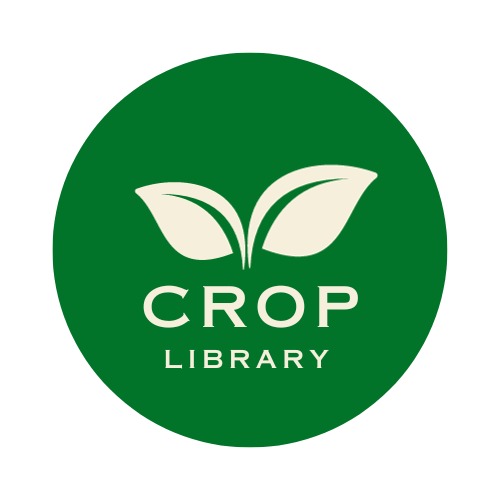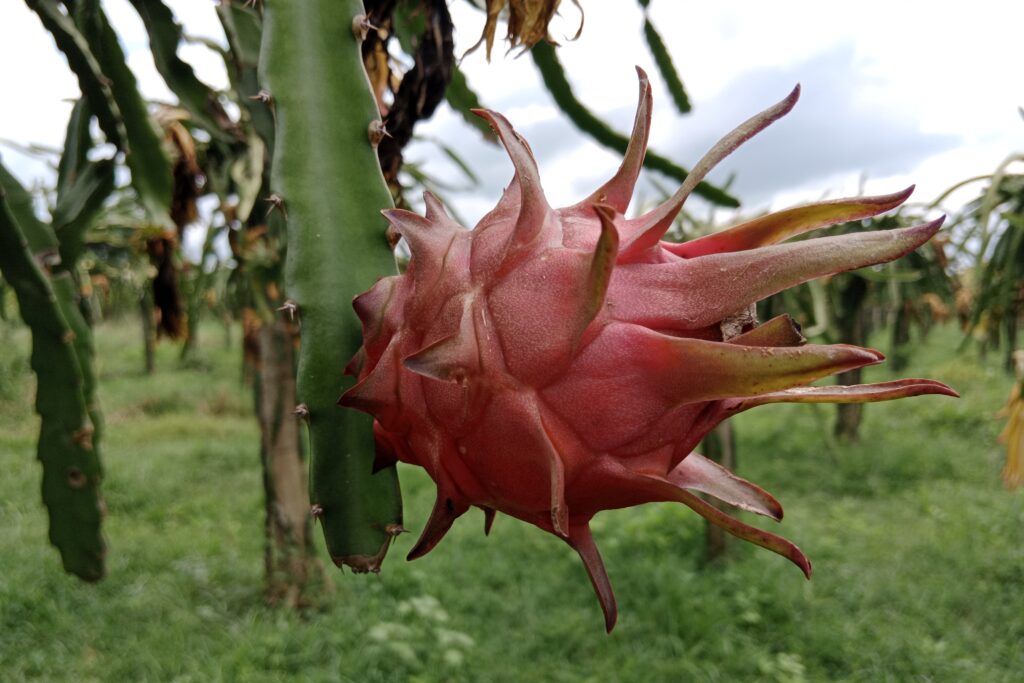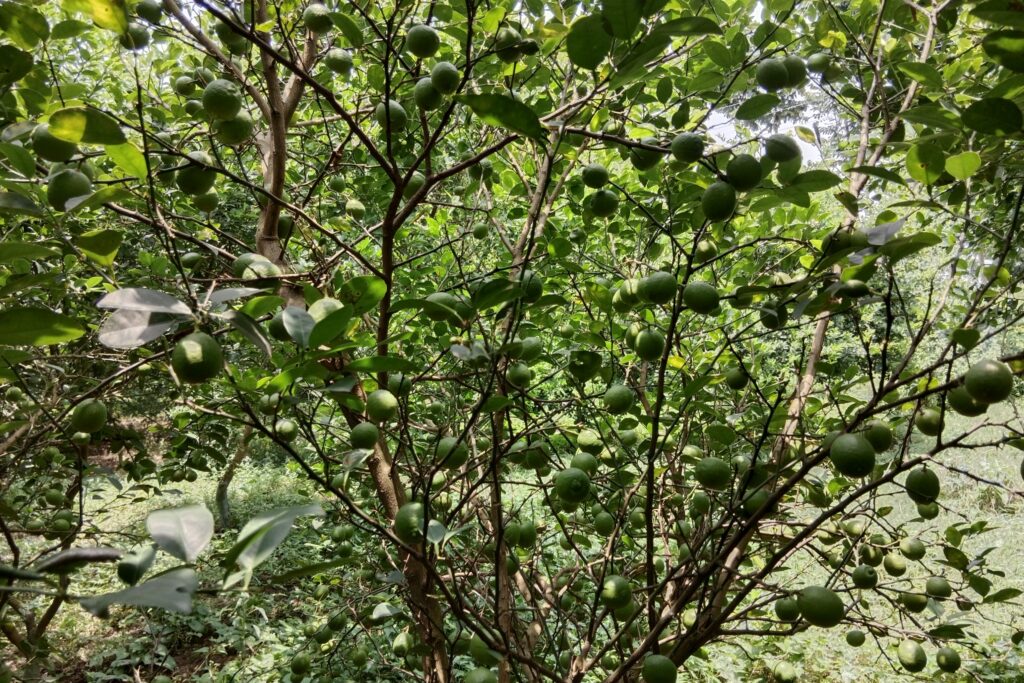Pea Farming Profit Per Acre
Peas (Pisum sativum) are a cool-season legume vegetable cultivated for their fresh green seeds, pods, or as a dry pulse. They are highly nutritious and have significant market value. Successful cultivation requires attention to specific agronomic practices.
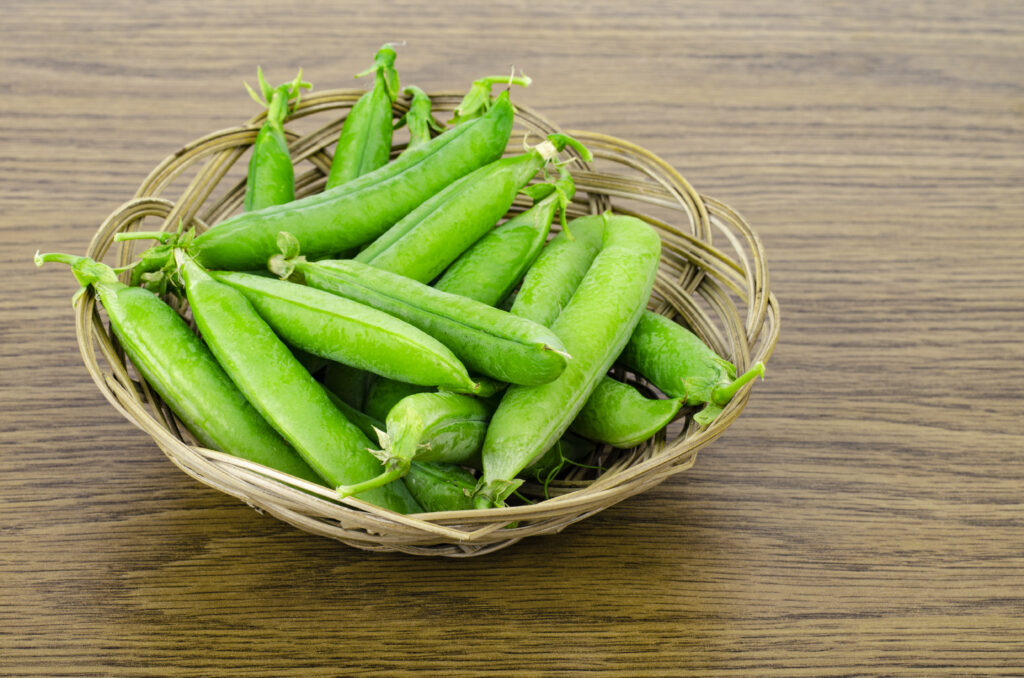
Pea farming has emerged as one of the most lucrative vegetable crops for small and large-scale farmers, offering substantial economic returns when managed effectively. With a total investment of NRs. 51,000 per acre, a well-managed pea crop can generate a total income of NRs. 250,000, resulting in a net profit of NRs. 199,000 per acre.
This demonstrates an impressive return on investment (ROI) of approximately 390%, making it a highly attractive option for farmers seeking sustainable and high-yielding crops. Considering these figures, the potential Pea Farming profit per acre clearly underscores its financial viability and encourages adoption of proper agronomic practices to maximize yield and quality.
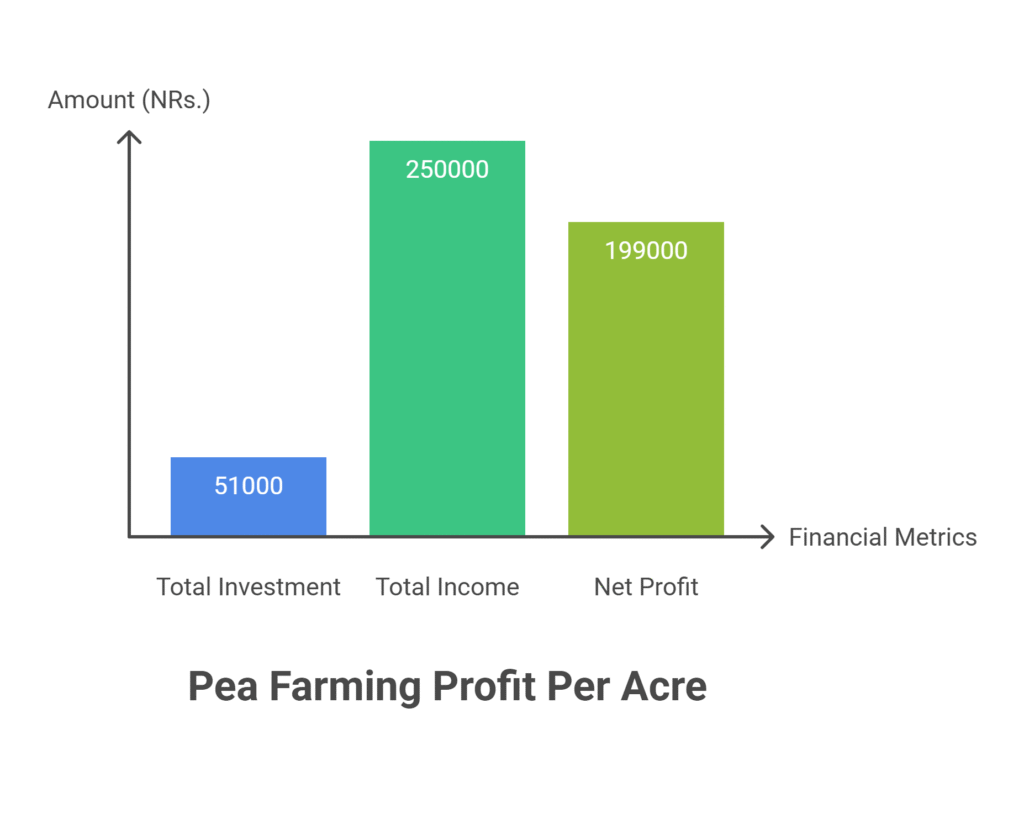
Land Preparation
Proper land preparation is essential for ensuring good germination and healthy root development. The process begins with primary tillage, where the field is plowed deeply (20–25 cm) using a moldboard plow to bury crop residues, control weeds, and improve soil aeration.
Afterward, the field is left for a few days for solarization to reduce soil-borne pests and diseases, followed by 2–3 rounds of secondary tillage using a disc harrow or cultivator to break down large soil clods.
Levelling is then carried out to facilitate uniform irrigation and avoid waterlogging, while bed formation depends on the crop type and local conditions—raised beds are preferred for dwarf varieties or in heavy rainfall areas, whereas flatbeds are suitable for vining varieties requiring support. Ultimately, the soil should be brought to a fine tilth, achieving a loose, crumbly, and well-pulverized structure ideal for planting.
Soil Type
Peas grow best in well-drained, loamy soils rich in organic matter, with an optimal pH range of 6.0 to 7.5, as they are moderately tolerant to soil acidity. However, heavy clay soils that tend to become waterlogged can lead to seed rot and poor germination, while very light sandy soils are unsuitable as they dry out quickly and fail to retain sufficient nutrients for proper crop growth.
Climatic Requirements
Peas are a classic cool-season crop, thriving in conditions that are too chilly for many other garden plants. Their growth cycle is perfectly suited to the gentle warmth of spring and autumn, rather than the intense heat of summer.
Growing peas requires a temperature range of 10°C to 22°C (50°F to 72°F). The soil must be between 5 and 10°C for seeds to germinate. However, excessive heat, especially above 26°C (80°F) during the crucial stages of blooming and pod formation, results in serious issues. This heat stress results in rough, low-quality pods, poor pollination, and a lower yield.
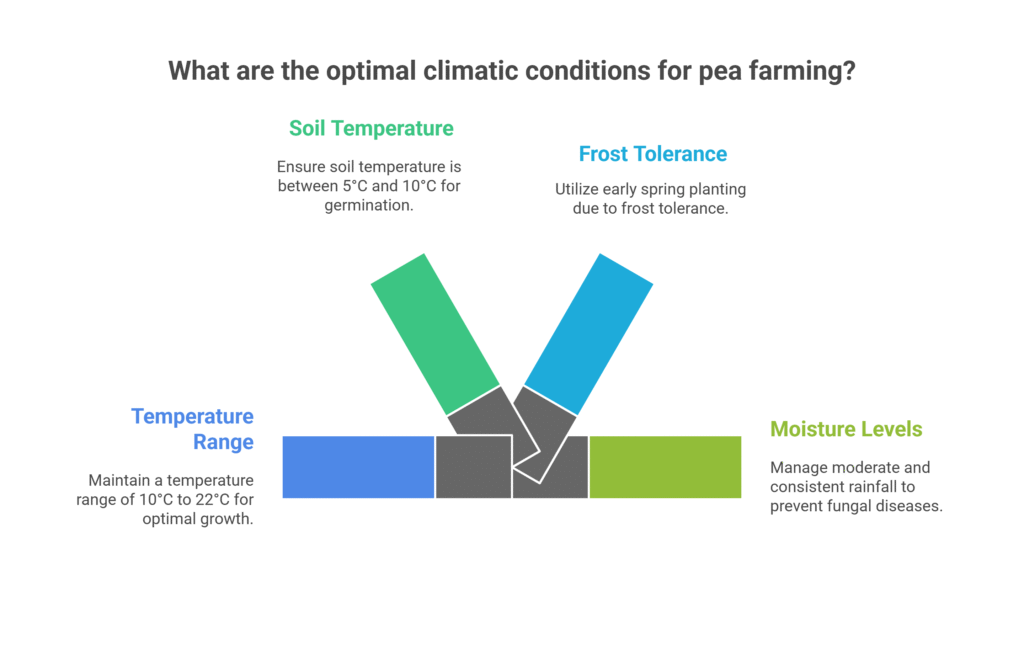
A beneficial trait of pea plants is their ability to withstand light frosts, especially during their early vegetative growth phase. This hardiness allows for early spring planting. However, a hard, severe frost can be damaging, often injuring delicate flowers and very young pods.
When it comes to moisture, peas perform best with moderate and consistent rainfall. Too much water can be detrimental; high humidity and excessive rain during the flowering period create ideal conditions for fungal diseases to develop and spread throughout the crop.
Major Cultivars
Pea cultivars are selected based on their purpose—fresh market, processing, or dry peas—as well as plant height and pod traits. Fresh market varieties emphasize sweetness and appearance, while processing types focus on uniformity and disease resistance, and dry peas are chosen for high-yielding, storable seeds.
Plant height influences management and harvesting, with dwarf types suited for mechanization and vining types for higher yields. Pod characteristics such as size, tenderness, and fiber content also determine whether cultivars are grown for edible pods, like snow and snap peas, or for shelled seeds, like garden peas.
| Category | Purpose / Description | Varieties |
| Garden Peas | Grown for round, shelled seeds; pods not eaten | Early Varieties: Arkel, Mithi Phali, LincolnMain Season Varieties: Bonneville, Jawahar Matar-1, -3, -4 |
| Snow Peas | Grown for flat, tender pods with undeveloped seeds; entire pod eaten | Oregon Sugar Pod, White Snow |
| Snap Peas | Cross between garden and snow peas; both fleshy pod and seeds eaten | Sugar Ann, Sugar Daddy |
| Field Peas | Dwarf varieties grown for dry pea production (as a pulse) | — |
Propagation
Peas are propagated sexually through seeds. They are almost exclusively direct-seeded in the field; transplanting is not common due to their sensitivity to root disturbance.
Seed Rate per Acre
The seed rate for peas varies depending on the variety, seed size, and sowing method, with dwarf varieties requiring about 25–30 kg per acre and vining or tall varieties needing 15–20 kg per acre. To ensure healthy crop establishment, seeds should be treated with a fungicide such as Thiram or Captan at 2–3 g per kg of seed to protect against soil-borne fungal diseases, while inoculation with Rhizobium bacteria is also recommended to enhance nitrogen fixation and improve overall plant growth.
Planting
a). Planting Season
The planting season for peas varies with location, as in the plains sowing is typically done from October to November after the monsoon heat subsides, while in hilly regions peas are sown either in spring (February–March) or during autumn (July–August) depending on the climatic conditions.
b). Spacing
The spacing of peas depends on the growth habit of the variety, with bushy or dwarf types planted at 30 cm between rows and 5 cm between plants, while vining or tall types require wider spacing of 45–60 cm between rows and 10 cm between plants to accommodate staking and ensure proper aeration.
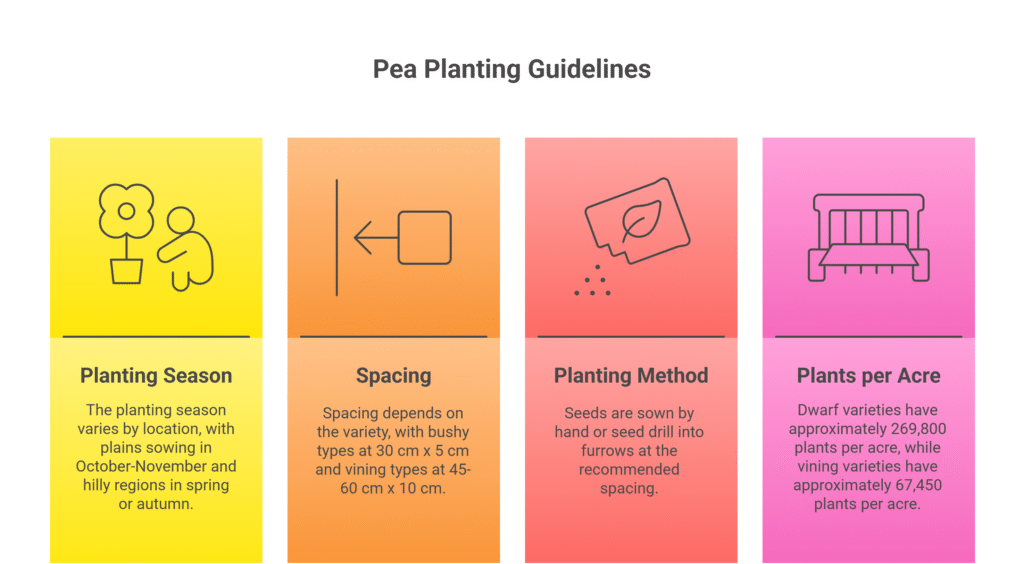
d). Planting Method
| Planting Method | Description | Depth/Spacing |
| Drilling | Seeds are sown by hand or seed drill into furrows made at the recommended spacing. | 3–5 cm deep |
| Dibbling | Seeds are placed manually at the recommended spacing. | As per recommended spacing |
e). Number of Plants per Acre
| Variety Type | Spacing | Approximate Number of Plants per Acre |
| Dwarf Varieties | 30 cm × 5 cm | ~269,800 plants |
| Vining Varieties | 60 cm × 10 cm | ~67,450 plants |
Intercropping
Peas are well-suited for intercropping because of their short stature and nitrogen-fixing ability, making them a valuable addition to farming systems. They are commonly intercropped with taller crops such as maize, sugarcane, or okra, where peas efficiently utilize the space between the rows of the main crop. Typically, they are planted in a 2:1 or 3:1 ratio of main crop rows to pea rows, ensuring better land use and mutual benefits for both crops.
Irrigation
Peas require consistent soil moisture for optimal growth, particularly during flowering and pod development, though waterlogging must be avoided. The first irrigation is applied immediately after sowing to ensure good germination, followed by critical irrigations at the pre-flowering, flowering, and pod-filling stages.
In the absence of rainfall, fields should be irrigated every 7–10 days during winter, with drip irrigation being the most efficient method as it conserves water and keeps foliage dry, thereby reducing disease incidence. Irrigation should be stopped once pods mature to promote uniform ripening and facilitate harvesting.
Fertilizer and Manure
As a legume, peas fulfill a significant portion of their nitrogen requirements through symbiotic nitrogen fixation, but they have substantial needs for phosphorus and potassium. To meet these nutrient demands, a full dose of farmyard manure (FYM), phosphorus, and potassium, along with half of the recommended nitrogen, should be applied as a basal dose at sowing. The remaining half of the nitrogen is then applied as a top dressing 30–40 days after sowing to support optimal growth and pod development.
| Fertilizer Type | Recommended Dose per Acre | Notes / Examples | ||
| Organic Manure | 8–10 tonnes | Well-decomposed Farm Yard Manure (FYM) or compost applied during the last plowing | ||
| Biofertilizer | 800 g each | Azospirillum, PSB, and Potash-mobilizing bacteria | ||
| Chemical Fertilizers | ||||
| Nitrogen (N) | 20–25 kg | Example: 50 kg of Urea | ||
| Phosphorus (P₂O₅) | 50–60 kg | Example: 125 kg of Single Super Phosphate | ||
| Potassium (K₂O) | 40–50 kg | Example: 70 kg of Muriate of Potash | ||
Weed Control
In pea production, weed control is essential because weeds fiercely compete with immature pea plants for sunshine and nutrients. In order to control weeds, the first 30 to 45 days following sowing are very crucial. Culturally, it can be quite beneficial to do a shallow hoeing and weeding about three to four weeks after sowing. Chemically, pre-emergence application of Pendimethalin or pre-plant incorporation of herbicides like Fluchloralin might help inhibit weed development; nevertheless, to ensure safety and efficacy, it is crucial to strictly follow the label recommendations.
Inter Culture Operation
Interculture operations in pea cultivation, particularly training and pruning, play a supportive role in crop management. Training is essential for tall, vining varieties, where plants are supported using stakes, wooden sticks, or strings to keep pods off the ground, prevent rotting, facilitate easier harvesting, and enhance both yield and quality. Pruning, however, is generally not a standard practice for peas.
Flowering and Fruit Management
Flowering in peas typically begins 45–60 days after sowing, depending on the variety, and the flowers are naturally self-pollinated. For fruit management, no specific thinning of pods is required; instead, ensuring adequate moisture and nutrient availability during this stage is crucial to support proper pod set and development, ultimately contributing to higher yield and quality.
Pest and Disease Management
Common Pests
a). Aphids
Aphids are tiny, sap-sucking insects that can spread viral infections and seriously harm pea plants by consuming their sap. Severe infestations can weaken plants, impede their growth, and limit their yields. Insecticides like Acetamiprid (20 SP) at 0.2 g per liter of water or Imidacloprid (17.8% SL) at 0.3 to 0.5 mL per liter of water can be used to control aphids. Depending on the extent of the infestation, evenly mist the crop with the solution, ideally in the morning or late at night, and repeat as needed every 10 to 15 days.
b). Pod Borer
Pod borer larvae bore into developing pods and feed on seeds, causing direct yield loss and reducing market quality. Effective chemical control includes Spinosad at 0.25 mL per liter of water or Emamectin benzoate at 0.5 g per liter of water. Biological control is also highly recommended, using Bacillus thuringiensis (Bt), which targets larvae without harming beneficial insects. Spraying should be done when larvae are small for maximum effectiveness, and multiple applications may be needed depending on pest pressure.
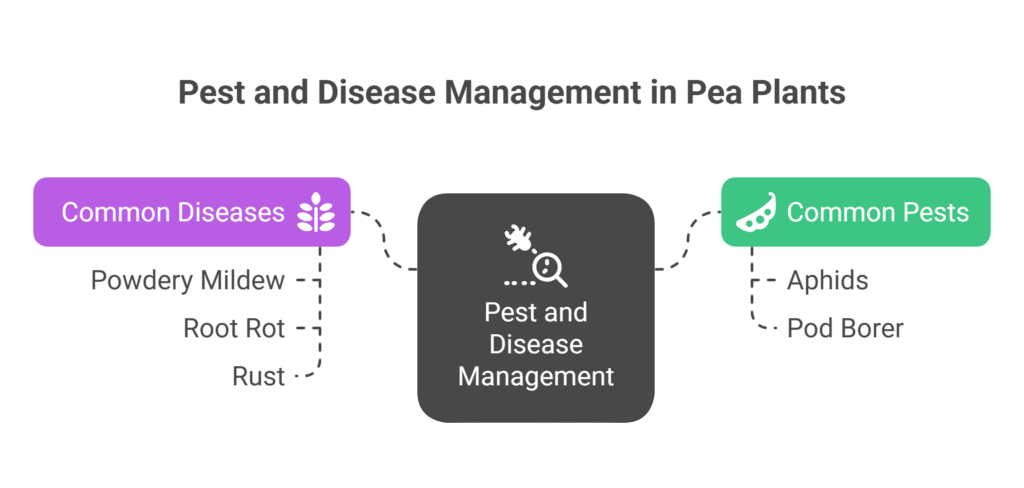
Common Diseases
a). Powdery Mildew
Powdery mildew reduces photosynthesis and overall plant vigor by appearing as white, powdery growth on leaves, stems, and pods. Apply sulfur dust (3–5 g per plant) or spray Dinocap (40 EC) at a rate of 1 mL per liter of water to control this disease. One milliliter of azoxystrobin (25 SC) per liter of water is another efficient choice. If conditions are still conducive to the sickness, sprays should be administered at the beginning of symptoms and then again every 10 to 14 days.
b). Root Rot
Root rot in peas is primarily caused by waterlogged soils, leading to poor root development, stunted growth, and plant death. Prevention is the most effective strategy: ensure proper field drainage and avoid over-irrigation. Additionally, treating seeds with Trichoderma spp. at 10 g per kg of seeds before sowing can suppress soil-borne pathogens and reduce disease incidence.
c). Rust
Rust manifests as reddish-brown pustules on leaves and stems, which can lead to defoliation and reduced yield. Effective chemical control includes spraying Mancozeb (75 WP) at 2 g per liter of water or Propiconazole (25 EC) at 1 mL per liter of water. Applications should begin when the first symptoms appear and repeated every 10–14 days depending on disease severity and environmental conditions.
Harvesting
Harvesting time in peas varies according to the purpose and variety. For green pods intended for the fresh market, pods are harvested when well-filled yet tender and bright green, typically 65–80 days after sowing, and are carefully plucked by hand to avoid damaging the vines.
For processing purposes, harvesting occurs at a precise stage of maturity and is often done mechanically to ensure uniformity. When producing dry seeds, the crop is allowed to mature fully on the plant until the pods turn dry and yellow, after which the plants are cut, dried, and threshed to separate the dry peas.
Yield
| Yield Type | Expected Yield per Acre | Notes |
| Green Pod Yield | 2,000 – 3,000 kg | For good dwarf varieties |
| Shelled Green Peas Yield | 800 – 1,200 kg | Harvested for consumption as shelled peas |
| Dry Grain Yield | 600 – 800 kg | Fully matured dry peas |
Cost of Investment per acre for Peas Farming
| S.N. | Categories | Cost of Investment (NRs.) |
| 1 | Land Preparation | 15,000 |
| 2 | Seed | 2,000 |
| 3 | Sowing | 4,000 |
| 4 | Fertilizers and Manure | 8,000 |
| 5 | Irrigation | 5,000 |
| 6 | Weed Control (pre & post-emergence) | 3,000 |
| 7 | Pest & Disease Control | 3,000 |
| 8 | Harvesting | 6,000 |
| 9 | Miscellaneous Costs | 5,000 |
| Total Cost | 51,000 |
Income per Acre from Farming Peas
| Yield Type | Estimated Yield per Acre (Kg) | Market Price (NRs./kg) | Total Income (NRs.) |
| Green Pod Yield | 2,500 | 100 | 250,000 |
Analysis of Pea Farming Profit Per Acre
| Metric | Calculation | Amount (NRs.) |
| Total Investment | (Sum of all costs) | 51,000 |
| Total Income | (Yield × Market Price) | 250,000 |
| Net Profit | (Income – Investment) | 199,000 |
| Return on Investment (ROI) | (Net Profit / Investment) × 100 | 390.2% |
| Cost-to-Income Ratio | (Investment / Income) | 1 : 4.9 |
Pea farming is highly profitable, with a total investment of NRs. 51,000 per acre generating a total income of NRs. 250,000. This results in a net profit of NRs. 199,000 per acre and an impressive return on investment (ROI) of approximately 390%, highlighting the financial viability of cultivating peas when proper management practices are followed.
Crop Calendar
| Aspect | Category | Details & Specifications |
| 1. Crop Overview | Description | Cool-season legume cultivated for green pods, shelled seeds, or dry pulses. Highly nutritious and profitable. |
| Climatic Requirements | Temp: 10-22°C (Optimal). Germination Temp: 5-10°C. Frost: Tolerates light frosts. Moisture: Moderate, consistent rainfall; high humidity promotes disease. | |
| Preferred Soil | Well-drained loamy soils rich in organic matter. pH: 6.0 – 7.5. Avoids heavy clay and waterlogged conditions. | |
| 2. Pre-Planting | Land Preparation | Deep plowing (20-25 cm), 2-3 harrowings, leveling. Form raised beds for dwarfs/flatbeds for vines. |
| Seed Rate & Treatment | Dwarf: 25-30 kg/acre. Vining: 15-20 kg/acre. Treat with: Fungicide (Thiram 2-3g/kg) + Rhizobium/PSB biofertilizer. | |
| Basal Fertilization (At sowing) | FYM: 8-10 tonnes. N: 10-12.5 kg (Half dose). P₂O₅: 50-60 kg. K₂O: 40-50 kg. Incorporated during last plowing. | |
| 3. Planting | Sowing Time | Plains: Oct-Nov. Hills: Feb-Mar (Spring) or Jul-Aug (Autumn). |
| Method & Spacing | Method: Drilling or dibbling. Depth: 3-5 cm. Spacing: Dwarf: 30 cm x 5 cm. Vining: 45-60 cm x 10 cm. | |
| 4. Crop Management | Irrigation | 1st: Immediately after sowing. Subsequent: Every 7-10 days. Critical Stages: Flowering & pod development. Stop irrigation 10-15 days before dry harvest. |
| Weed Control | Critical Period: First 30-45 DAS. Cultural: Shallow hoeing at 25-30 DAS. Chemical: Pre-emergence Pendimethalin. | |
| Top-Dressing | Apply remaining half dose of N (10-12.5 kg) at 30-40 Days After Sowing (DAS). | |
| Training | Essential for vining types. Use stakes or trellises to keep pods off the ground. | |
| 5. Pest & Disease Control | Major Pests | Aphids: Imidacloprid (0.3-0.5 ml/L) or Acetamiprid (0.2 g/L). Pod Borer: Spinosad (0.25 ml/L) or Emamectin benzoate (0.5 g/L). |
| Major Diseases | Powdery Mildew: Sulfur dust or Dinocap (1 ml/L). Rust: Mancozeb (2 g/L) or Propiconazole (1 ml/L). Root Rot: Prevent with drainage; seed treat with Trichoderma. | |
| 6. Harvesting & Yield | For Green Pods | Time: 65-80 DAS. Stage: Pods tender, bright green, well-filled. Method: Hand-picked. Yield: 2,000 – 3,000 kg/acre. |
| For Dry Peas | Time: 90-110 DAS. Stage: Pods dry and yellow. Method: Cut plants and thresh. Yield: 600 – 800 kg/acre. | |
| 7. Economics (Investment) | Cost Breakdown | Land Prep: NRs. 15,000. Seed: NRs. 2,000. Sowing: NRs. 4,000. Fertilizer/Irrigation: NRs. 13,000. Weed/Pest Control: NRs. 6,000. Harvesting/Misc: NRs. 11,000. |
| Total Investment | NRs. 51,000 per acre. | |
| 8. Economics (Income & Profit) | Income (Green Pods) | Yield: 2,500 kg/acre. Market Price: NRs. 100/kg. Total Income: NRs. 250,000. |
| Profit Analysis | Net Profit: NRs. 250,000 – NRs. 51,000 = NRs. 199,000/acre. Return on Investment (ROI): (199,000 / 51,000) * 100 = ~390%. Cost-to-Income Ratio: 1 : 4.9. |
Note: DAS = Days After Sowing. Timings and yields are estimates and may vary based on local conditions, variety, and management practices.
Also Read: Green Beans Farming Profit Per Acre
Sources
Food and Agriculture Organization (FAO)
University of California Agriculture & Natural Resources (UC ANR)
European Plant Protection Organization (EPPO)
Punjab Agricultural University (PAU)
Tamil Nadu Agriculture University (TNAU) – Agritech portal
Indian Council of Agricultural Research (ICAR)
Nepal Agricultural Research Council (NARC)
U.S. Department of Agriculture (USDA).
Ministry of Agriculture and Livestock Development (Nepal)
Disclaimer: This crop farming profits assume optimal conditions. Actual results may vary depending on climate, market prices, and farm management practices.
